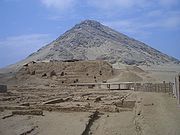
Huaca de la Luna
Encyclopedia




Adobe
Adobe is a natural building material made from sand, clay, water, and some kind of fibrous or organic material , which the builders shape into bricks using frames and dry in the sun. Adobe buildings are similar to cob and mudbrick buildings. Adobe structures are extremely durable, and account for...
brick
Brick
A brick is a block of ceramic material used in masonry construction, usually laid using various kinds of mortar. It has been regarded as one of the longest lasting and strongest building materials used throughout history.-History:...
structure built mainly by the Moche
Moche
'The Moche civilization flourished in northern Peru from about 100 AD to 800 AD, during the Regional Development Epoch. While this issue is the subject of some debate, many scholars contend that the Moche were not politically organized as a monolithic empire or state...
people of northern Peru
Peru
Peru , officially the Republic of Peru , is a country in western South America. It is bordered on the north by Ecuador and Colombia, on the east by Brazil, on the southeast by Bolivia, on the south by Chile, and on the west by the Pacific Ocean....
. Along with the Huaca del Sol
Huaca del Sol
The Huaca del Sol is an adobe brick temple built by the Moche civilization on the coast of what is now Peru. The temple is one of several ruins found near the peak of Cerro Blanco, in the coastal desert near Trujillo, Peru...
, the Huaca de la Luna is part of Huacas de Moche, which is the remains of an ancient Moche capital city called Cerro Blanco.
Background
The Huacas de Moche site is located 4 km outside the modern city of TrujilloTrujillo, Peru
Trujillo, in northwestern Peru, is the capital of the La Libertad Region, and the third largest city in Peru. The urban area has 811,979 inhabitants and is an economic hub in northern Peru...
, near the mouth of the Moche River valley. The Huaca de la Luna, though it is the smaller of the two huaca
Huaca
In Quechua, a Native American language of South America, a huaca or waqa is an object that represents something revered, typically a monument of some kind. The term huaca can refer to natural locations, such as immense rocks. Some huacas have been associated with veneration and ritual...
s at the site, yields the most archaeological information. The Huaca del Sol was partially destroyed and looted by Spanish conquistador
Conquistador
Conquistadors were Spanish soldiers, explorers, and adventurers who brought much of the Americas under the control of Spain in the 15th to 16th centuries, following Europe's discovery of the New World by Christopher Columbus in 1492...
s in the 17th century, while the Huaca de la Luna was left relatively untouched. It is believed today that the Huaca del Sol may have been more administrative, military, residential and burial mound for the Moche elite, while the Huaca de la Luna served a largely ceremonial and religious function, though it contains burials as well.
Though today the Huaca de la Luna is colored the soft brown of its adobe brickwork, just after its construction it would have been an impressive site to behold. The huaca was decorated in registers of murals which were painted in black, bright red, sky blue, white, and yellow. The sun and weather has since faded these murals away, but other murals used in earlier phases of construction can still be seen inside the Huaca. Many of these depict a deity now known as Ayapec. "Ayapec" is a pre-Quechua word translating as all knowing. "Wrinkle-Face" is the name given to another deity by the later Inca because of the deity's appearance.
Many of the later bricks used in the structure bear one of over 100 different markings, maybe corresponding to each group of laborers. Each "team" was maybe assigned a mark to put on their bricks, and these were used to count the number of bricks laid for financial as well as (presumably) competitive purposes.
The Huaca de la Luna itself is a large complex of three main platforms, each one serving a different function. The northernmost platform, at one time brightly decorated with a variety of murals and reliefs, was destroyed by looters. Because of this, the central and southern platforms have been the focus of most excavations. The central platform has yielded multiple high-status burials interred with a variety of fine ceramics, suggesting that it was used as a burial ground for the Moche religious elite, while the Huaca del Sol may have been used for the interment of rulers.
The eastern platform, black rock & adjacent patios were the site of human sacrifice rituals which are depicted in a variety of Moche visual arts, most notably painted ceramics. After their sacrifice, bodies of victims would be hurled over the side of the Huaca and left exposed in the patios. This finding is supported by the discovery of multiple skeletons of adult males found at the foot of the rock, all of whom show signs of grisly trauma, usually a severe blow to the head, as the cause of death.
The World Monuments Fund
World Monuments Fund
World Monuments Fund is a private, international, non-profit organization dedicated to the preservation of historic architecture and cultural heritage sites around the world through fieldwork, advocacy, grantmaking, education, and training....
has been working at Huaca de la Luna because the site requires conservation work, including ongoing assessments, documentation, stabilization, and consolidation of excavated architectural and decorative elements.
External links


